
Budget Gaming Showdown: The GeForce2 MX vs. the Kyro II
Posted By Joel Hruska
Date: October 5th, 2001
While the budget video card market is not as glamorous or exciting as reviewing the latest high-end GeForce3 Ti or upcoming Radeon 8500 cards, its arguably more important. For every gamer putting a computer together on a no-holds barred budget, there’s a dozen trying to figure out how to squeeze the most performance from a tightly limited checkbook. Oftentimes, for gamers like this, even a $60-$100 dollar investment is a major part of their available cash, and each purchase must be carefully considered.
For that reason we are looking at two budget video card solutions today and a higher performing GeForce2 Pro. The GeForce2 Pro is not the newer GeForce2 Ti 200, but tests have shown the two as performing equivalently. Before we get started with benchmarks lets take a look at the competition and the companies behind them.
===================================
NVIDIA’s Budget Solution: The GeForce2 MX 400
The GeForce2 MX has been discussed in numerous articles and has been highly covered, so we’ll provide just a brief summary here of its features. The card we tested was provided by NVIDIA and is a 64 Megabyte solution with a 128-bit SDR interface. The card was clocked at a 200 Mhz core speed and a memory bus speed of 166 Mhz, for a total memory bandwidth of 2.7 Gb/s.
The MX 400 is a refinement of the earlier MX design which earned high praise for delivering good performance at a budget price. The card can typically be found for between $70-90 from reputable online dealers and is available in a wide variety of formats, some of which carry TV-outs or even TV-ins and other digital video features.
The GeForce2 line of cards has proven remarkably successful for NVIDIA and allowed them to build a dominant market position in short order. From the GeForce2 MX to the GeForce2 Ultra, NVIDIA has built a reputation of providing a high quality, stable, and powerful gaming experience, with cards at a variety of price points and feature sets.
===================================
The Contender: The Hercules Prophet 4500
The contender and dark horse candidate of this battle is the Hercules Prophet 4500. Based on the Kyro II chipset, the Prophet 4500 takes a very different approach to 3D rendering. Rather than use the traditional Immediate Mode Rendering, where every object on a screen is drawn and then unnecessary pixels (already fully shaded and textured) are thrown out, the Kyro II uses a tile-based rendering system that groups polygons into display lists—then renders individual tiles. Because tiles are rendered before lighting and texturing are applied, the total amount of bandwidth wasted by overdraw is greatly or completely diminished. Lighting and texture information for non-visible pixels does not need to travel across the card’s memory bandwidth—and therefore puts much less of a strain on the memory system.
Tile based rendering is a completely different approach to video card design that Imagination Technologies (developers of the Kyro II chipset) have been working with for years. The Dreamcast system used a tile-based rendering design, as did early video cards marketed under the PowerVR name. The method has had its share of bugs and design flaws, however, and only with the Kyro II have Imagination Technology and STMicroelectronics brought a highly competitive product to market.
The Prophet 4500 is clocked at a 175 Mhz core and memory speed giving it a theoretical bandwidth of 2.8 Gb/s and a theoretical fill rate of 350 megapixels per second. This number is a bit deceiving, however, as the Prophet’s tile-based rendering system helps to eliminate overdraw and lower the need for a higher fillrate.
The card also definitely beats the GeForce 2 line in physical looks—it sports a very cool dark blue PCB over the standard green model, and the Blue Orb lookalike fan is a definite hit.
===================================
Image Quality, Hardware T&L, and Bump Mapping
One of the major differences between the Kyro II and the GF2 is that the Kyro II supports Environmental Bump Mapping (EBM) but lacks a Hardware T&L unit. On a sufficiently fast processor this is not a problem, but lower end CPU’s will suffer when running Hardware T&L games.
One place where the Kyro II has an immediate edge over the GeForce2 line is in 16-bit rendering in 3D mode. The cards are comparable in 2D desktop work and in 32-bit color, but the Kyro II renders internally in 32-bit color at all times, outputting at 16-bit when necessary. This lends the chip an immediate edge in 16-bit color games.
===================================
The Test
I’ve included reference scores from a GeForce2 Pro for comparison although this card, strictly speaking, is not in the price range of the other two (at least not in retail boxed form).
All tests were performed on the following system:
AMD Athlon 1200 @ 266 Mhz FSB
IWILL KK266
256 Meg PC133 RAM
7200 RPM 40 Gigabyte Seagate Hard Drive
Windows 2000 with DX8 and SP2 was used.
The latest Detonator XP drivers and driver version 8.162a were used for the video cards. In Quake 3, the latest Demo4 was used (1.30 version). Sound was on.
===================================
3DMark2001: 1024x768x16
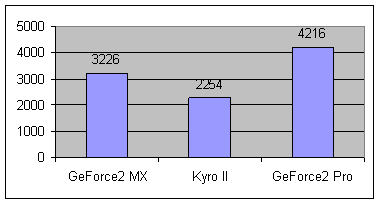
In 3DMark2001 we see both the GeForce cards clearly take the lead over the Kyro II, though the Kyro II possesses a definite edge in terms of image quality in 16-bit color. More serious, however, was the obvious display bugs during the “Lobby” demo in 3DMark2001—the main character could be seen running through the pillars in several places. The “Lobby” demo was built using the same engine used in Max Payne—we’ll take a look at Max Payne later to see if the same problem persists.
===================================
3DMark2001: 1024x768x32
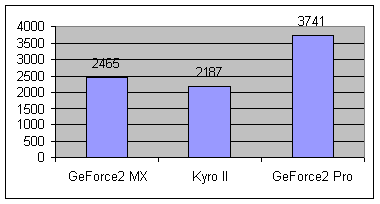
Here we see an interesting trend. The switch to 32-bit color drops the GeForce2 MX’s performance 24%. Even the GeForce2 Pro, a far more powerful card, takes an 11% performance hit. The Kyro II, by contrast, takes only a 3% performance hit, despite possessing only about 43% the memory bandwidth of the GeForce 2 Pro. Clearly the Kyro II’s unique rendering system is paying off for it here, though the visual artifacts in the “Lobby” demo persisted in 32-bit color. All other demos ran smoothly in both 16 and 32 bit color.
===================================
Quake 3: Arena: 640x480x16, Normal, Game Options Off
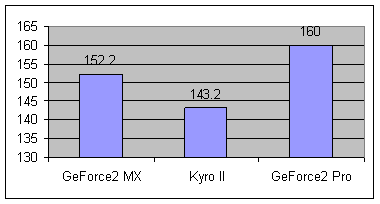
In this case, all three cards perform very close to each other. While the Kyro II trails the others slightly, it also has superior image quality in 16-bit color. There were no display issues or errata with any card.
===================================
Quake 3: Arena: 800x600x32, HQ, Game Options On
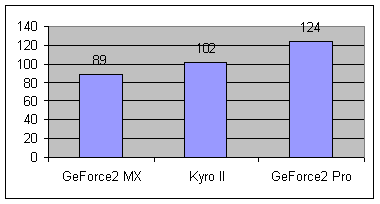
Here we see the Kyro II again passing the GeForce2 MX at higher detail levels. Despite a slower clock speed and fill rate, the Hercules Prophet pulls well ahead of the GeForce2 MX (although 89 fps is hardly ‘slow.’).
===================================
Quake 3: Arena: 1280x1024x32,Game Options On, All Detail Maxed
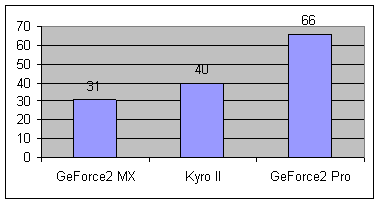
The results don’t change much at ultra-high detail. The Kyro II maintains a 23% higher frame rate than the GeForce2 MX at this detail level but only the GF2 Pro is able to maintain a consistent frame rate above 60 fps. Still, most budget gamers aren’t doing hardcore gaming at ultra-high resolution.
===================================
Max Payne: 1024x768x16, Max Detail and Sound
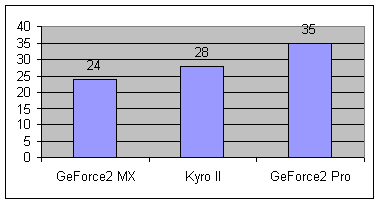
Max Payne was an interesting game to test for several reasons. It’s a game that uses hardware T&L extensively which should theoretically put the GeForce on strong footing. In addition, the “Lobby” demo in 3DMark that generated visual errors with the Kyro II was built on the same engine used in Max Payne. I’m happy to report, however, that the game ran flawlessly on all video cards.
The other interesting thing about Max Payne is that it most clearly demonstrated the superior 16-bit mode of the Kyro II. When using the GeForce2 cards, it was obvious whether the card was running in 32-bit or 16-bit color—but I was unable to tell the difference with the Prophet 4500.
===================================
Max Payne: 1024x768x32, Max Detail and Sound
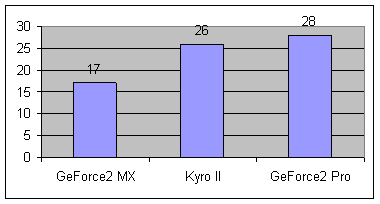
Even in 32-bit color, the picture doesn’t change. The Kyro II continues to demonstrate its bandwidth efficiency at high detail, losing only 2 fps in the switch, while the MX and Pro lose 7 frames each.
===================================
Unreal Tournament
I originally intended to include UT results—but frankly, the results weren’t really worth including. All three cards performed identically at 1024x768x16 and 1024x768x32, high detail, high textures. All three turned in results of approximately 42 fps when using UTBench. Again, the Kyro II’s driver support was flawless in UT.
===================================
Conclusion
So, after all the numbers and the benchmarks, what’s the right card for you?
If you’re in a situation where absolutely every dollar counts, but you want a reasonable degree of performance, the GeForce2 MX is a great pick. It’s the cheapest card in our lineup, it performs very well for its price, and it’s a rock-stable piece of equipment in 2D and 3D work. The GeForce2 MX is also the card to buy if you’ve got a slower (sub-600 Mhz) processor, as its GPU and hardware T&L will help make up for your lack of processor power.
If, on the other hand, you’ve got a little more money to spend and are willing to experiment with a new and different rendering system (or even desire to do so) you can’t go wrong with the Prophet 4500. Its definitely the equal of the GF2 in 2D work, surpasses it in 16-bit 3D, and scales better then the GeForce2. The faster your processor, the faster the Kyro II—and we all know that faster is better. Although the 3DMark glitches are troubling, the fact that they never re-occurred lead me to believe they are an isolated event. With a rumored Kyro II Ultra appearing soon, it may be possible to get even more bang for your buck—and the Kyro II proves it’s a marvelously efficient piece of equipment, racking up scores close to the GF2 Pro with less than 50% the bandwidth.
Finally, if you’ve got a few more dollars to burn, its obvious the GeForce2 Pro still has plenty of life in it. The real bottom line is that great video card performance is available for not a whole lot of money—and with the quality products on the market from both manufacturers today, it’d be hard to go wrong.
===================================
Pssst! Our Shopping Page has been updated.
===================================